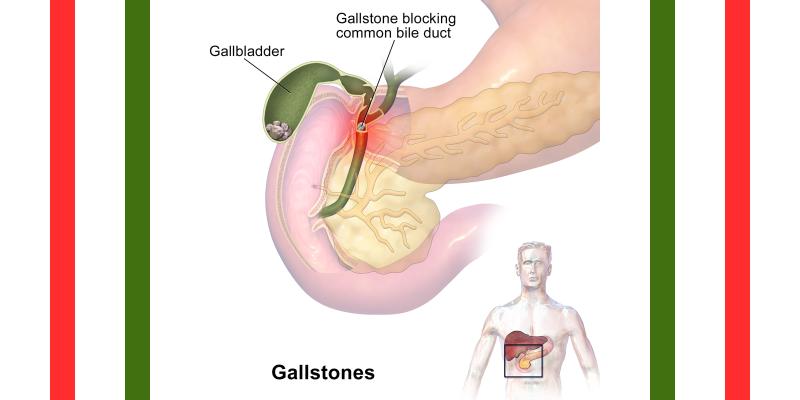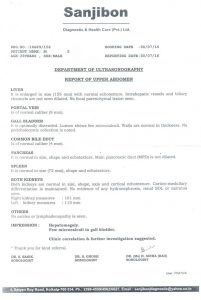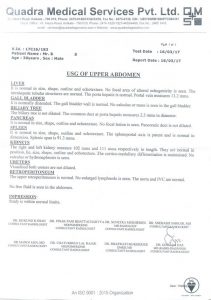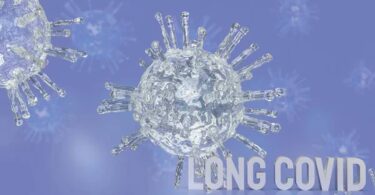Mr. B.S. 30 yrs. old, came to me first on 3rd September, 2016, complaining as follows:
- Recurrent pain in the right side of upper abdomen with eructations and sleepiness after eating meals. He also felt sleepy after an episode of pain.
- Poor appetite with sour regurgitations and water brash.
- Constipation with offensive smell in stool.
- Chilly patient.
- Likes spicy food, sweet ++, warm food ++, likes meat.
- Thirst: More, drinks 5L/Day.
- General Tendencies: Catches cold easily with recurrent fever
- Temperament: Irritable with a tendency to hit others and break things. Impatient and aversion to company.
- Fear: of darkness.
- Family History: (i) Father died at the age of 59 with asthma. (ii) Mother died of Hepatitis at the age of 48.
- USG report showed hepatomegaly and few micro calculi in GB.
Patient was on conventional painkillers thrice a day for the biliary colic for past one month. Due to heavy dependence on painkillers, even after spending considerable amount of time with the patient, he was unable to express symptoms which were of homoeopathic significance. Hence, the case was opened with a lesser known medicine on the basis of a few available symptoms that corroborated with the patient’s totality.
PRESCRIPTION CHART
| Dates | Points in favour of the prescription/Follow up notes | Prescribed Medicine
|
| 03 Sept 2016 | Tendency to sleep after eating.
Frequent eructations. |
Fel Tauri 3x |
| 01 Oct ‘16 | The severity of the pain had reduced. He was taking the painkillers once a day. | Fel tauri 3x |
| 04 Nov ‘16 | The intensity and frequency of pain had reduced. He had taken the painkillers only 2-3 times in the past 1 month. | The entire case was gone through again and a re-analysis was done so as to select a polychrest. |
Mr.B.S. was instructed on Sept 03,2016 that when he is having the attack of biliary colic and in need of a conventional painkiller, he can take Fel tauri 3x trituration (one fourth teaspoon in half cup of lukewarm water) and try to defer taking the conventional medicine as much as he can.
In the first follow up, Mr. B.S who used to take painkiller 8 hourly could, with the help of homoeopathic medicine now defer the painkiller to 24 hourly. In this way about 66% of the conventional medication was gradually weaned off in a month’s time.
In the second follow up, Mr. B.S. had withdrawn more than 90 % of the medication. The intensity of pains was less severe and whenever he had the pains, he took Fel tauri 3x which gave him instant relief. The administration of Fel tauri followed the three basic Homoeopathic principles:
Law of Similia (based on few available symptoms), Law of Simplex (one single simple substance administered) and Law of Minimum (3X in Decimal Scale).
After the patient has weaned off approximately 50% of the conventional medicine, suppressed symptoms surfaced and the patient could give much clearer modalities and sensations. The case was re-evaluated again on 04th Nov., 2016 and a change in plan of treatment was made.
CASE TAKING ON 04TH NOV.,2016
- Although the severity of the abdominal pain was much better, now he added the modality that the pain was ameliorated by vomiting.
- Nausea along with abdominal pain also relieved by vomiting.
- Flatulence and eructations with heaviness in the epigastrium.
- He also mentioned that the initiation and flaring up of gastric symptoms was after he had started taking the conventional painkillers.
- Appetite: Poor.
- Sweat: Normal.
- Stool & Urine: Constipated with sensation as if not finished, with offensive smell.
- Sexual Function: Nothing abnormal is noted.
- After eating eggs, there is some irritation and discomfort in the skin.
- Sleep & dreams: Occasionally disturbed.
MIASMATIC INTERPRETATION – PSORIC PREPONDERANCE:
(1) Flatulence (Lack of peristalsis or digestion) (2) Low appetite (Lack=Hypo=Psora) (3) Constipation with sensation as if not finished (4) Catches cold easily (Lack of immunity).
SYCOTIC BACKGROUND:
(i) Gall Bladder stone. (Excess=Sycosis) (ii) Heaviness in the epigastrium. (iii) Relief by vomiting. (Amelioration by unnatural discharge)
PRESCRIPTION CHART
| Dates | Points in favour of the prescription/Follow up notes | Prescribed Medicine |
| 04 Nov 2016 | Ø Conventional painkillers had triggered the onset of abdominal symptoms.
Ø Abdominal pain ameliorated by vomiting. Ø Heaviness in the epigastrium. Ø After stool, sensation as if not finished. Ø Irritable, impatient and aggressive. Ø Chilly patent. Ø Likes spicy, meat |
Nux Vomica 30/1
Followed by Nux Vomica 200/1 |
| 06 Dec ‘16 | Ø Abdominal pain and heaviness were 60% >.
Ø Stool was regular. Ø Appetite was still poor. |
Placebo |
| 31 Jan ‘17 | Ø His condition was standstill since last visit and he said appetite was almost nil.
Ø He had no desire to take any food. |
Nux Vomica 200/1 |
| 18 March ‘17 | Ø As a whole 80% >.
Ø Appetite has improved as well. Ø Follow up USG had been done which showed normal findings. |
Placebo |
PRESCRIBING METHODOLOGY-
At the start of treatment, patient was pain killer dependent.
The artificial chronic disease was superimposed on the original natural disease, therefore symptoms were contaminated or suppressed and the patient could not give a clear picture for a constitutional medicine and the modalities of the pain and sensations were masked.
Therefore, Fel tauri was prescribed on the basis of the few available symptoms (Frequent eructations and tendency to sleep after eating). 3x potency was chosen as an organopathic so as to stimulate the gall bladder.
Accordingly, the conventional painkiller was gradually withdrawn.
After approximately 50-60% weaning off of the conventional medicine, suppressed symptoms surfaced and now the patient could give much clearer modalities (> vomiting) and sensations (heaviness in abdomen and sensation as if not finished after stool).
This led to making a change in the plan of treatment and on the basis of ‘MTEK’ a polychrest, (Nux Vomica) as discussed above, could now be selected.
M = Miasmatic Totality
T = Totality of Symptoms
E = Essence (should include gestures, postures, behaviours etc)
K = Keynotes (which should encompass PQRS symptoms, refer §153 and §209 of Hahnemann’s Organon)
GUIDELINES IN THE ORGANON-
In Aphorism 91 of Organon, Hahnemann clearly mentions prescribing for natural disease and not for conjoint disease (where the drug induced artificial chronic disease is super-imposed on natural disease and patient cannot give us a clear picture e.g. modalities, sensation or characters of pain etc.). For example, in a pain-killer dependant migraine case, you ask the patient about the character of the pain (e.g. whether it is stitching, tearing, throbbing, dull aching, bursting, fullness etc) or you ask the modalities (e.g. if the pain is better by cold or warm application/flannel; how about the open air, warm room etc.) and the patient replies, whenever I have the pain, I take the pain killer; so, I don’t know! Therefore, you cannot frame an uncontaminated picture of the disease, as you are unable to complete the symptoms with sensations, modalities etc. to prescribe your powerful polychrest. In § 174-178, Hahnemann mentions that in one sided cases we can prescribe on the few available symptoms provided they are striking and characteristic.
UTILITY OF ORGANOPATHICS
In such a situation, which is common in the present drug dependant world, on the basis of the few available symptoms, prescribe an organopathic medicine (as discussed here) and start gradual weaning off of the conventional medicine. You may think that it can be risky but have the confidence that the patient has come to you because s/he is tired of the ever-increasing dosage of the conventional medication or its side effects. So, as soon as you have given the control of reducing the dosage into the hands of the patient, their will power also helps them in a positive way. They also get the confidence that (a) yes, I can control the dosage and may take fewer chemicals; (b) there are alternatives to manage my problem and (c) homoeopathy is working for me!
The weaning off will be very gradual, e.g. for a pain killer dependant migraine case, say the patient is taking a pain killer every 8 hours; select an Organopathic homoeopathic medicine and ask the patient that whenever s/he has the pain, she can take homoeopathic medicine, which is selected by you in accordance with the few available symptoms and try to defer (even 1 or 2 hours) the conventional medicine as much as s/he can. When he can’t endure anymore, take the pain killer; as homoeopathy will take some time and our main motto is to reduce the medication and get the uncontaminated picture of the natural disease. In this way, the pain-killer dependent patient who used to take the medication 8 hourly can, with the help of homoeopathic medicine, now defer the pain-killer to every 10 or 12 hours, then 24 hourly and so on. In this way, the conventional medication can be gradually reduced or weaned off of, if the patient wants (with the consent of the patient &/or GP).
So please prepare the patient for receiving the polychrest (PPPP)!
Through this approach, not only does the patient gain immediate confidence that homoeopathy is acting, but he has also weaned off the conventional medication to a certain extent.
Ultrasound findings before treatment
ULTRASOUND FINDINGS-AFTER TREATMENT









Excellent case!